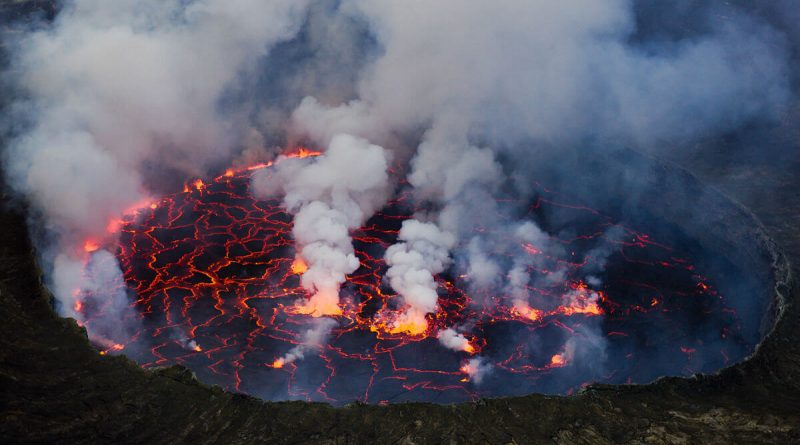Volcano Nyiragongo
Nyiragongo is classified as an active stratovolcano and is located in the Virunga National Park, about 20 km north of the city of Goma and Lake Kivu. Its main crater is about 2 km in diameter and usually contains a lava lake, the largest known in recent history. Until 1977, its depth was a record of about 3,250m; now the figure is about 2,700m.
Lava lake at Nyiragongo
From 1894 to 1977 the crater of the volcano contained an active lava lake. On 10 January 1977, part of the crater wall collapsed in the eruption, causing the lake to spill out in less than an hour. The lava, which flowed downhill at high speed, destroyed almost all the villages in the area and killed about 70 people. The crater soon filled up again, and until 2010 the lava was barely flowing out of the rims. Today, most of it is contained in a wide cinder cone at the bottom of the crater, which is 18.2 m high and 182.8 m wide.
Nyiragongo eruption history
Nyiragongo is one of the most active volcanoes in Africa. Together with nearby Mount Nyamlagira, it is responsible for 40% of all historical eruptions on the continent. It is not known exactly how many times the volcano has erupted, but it is known to have erupted at least 34 times since 1882. Some eruptions have lasted for years.
Volcanism at Nyiragongo is due to riftogenesis of the earth’s crust when two parts of the African plate collapse. Its lava is unusually fluid and consists mainly of alkali-rich volcanic rock. While most lava flows move rather slowly and rarely pose a threat to human life, Nyiragongo’s lava flows can rush down the slopes at speeds of up to 100 km/h. This is due to their very low lava content, which is very high. This is due to its very low silica content. Because of the threat Nyiragongo poses to surrounding settlements, it was listed as a Volcano of the Decade in 1991.
Nyiragongo volcanic eruptions
Scientists have been monitoring the giant since 1885 and in that time it has had some 30 eruptions, the process of which takes several years. The largest eruption on record is that of Nyiragongo in 1977, when the crater wall collapsed and the lava washed away everything in its path, killing a couple of hundred people. Note that due to the low silicate content of the lava, the lava is quite liquid and the velocity is much higher. It doesn’t just come out: like a burst pipe, it seeps out through cracks and holes, is under high pressure and eventually explodes.
You may also like:

